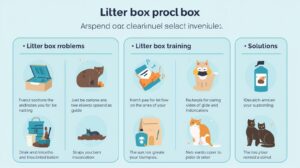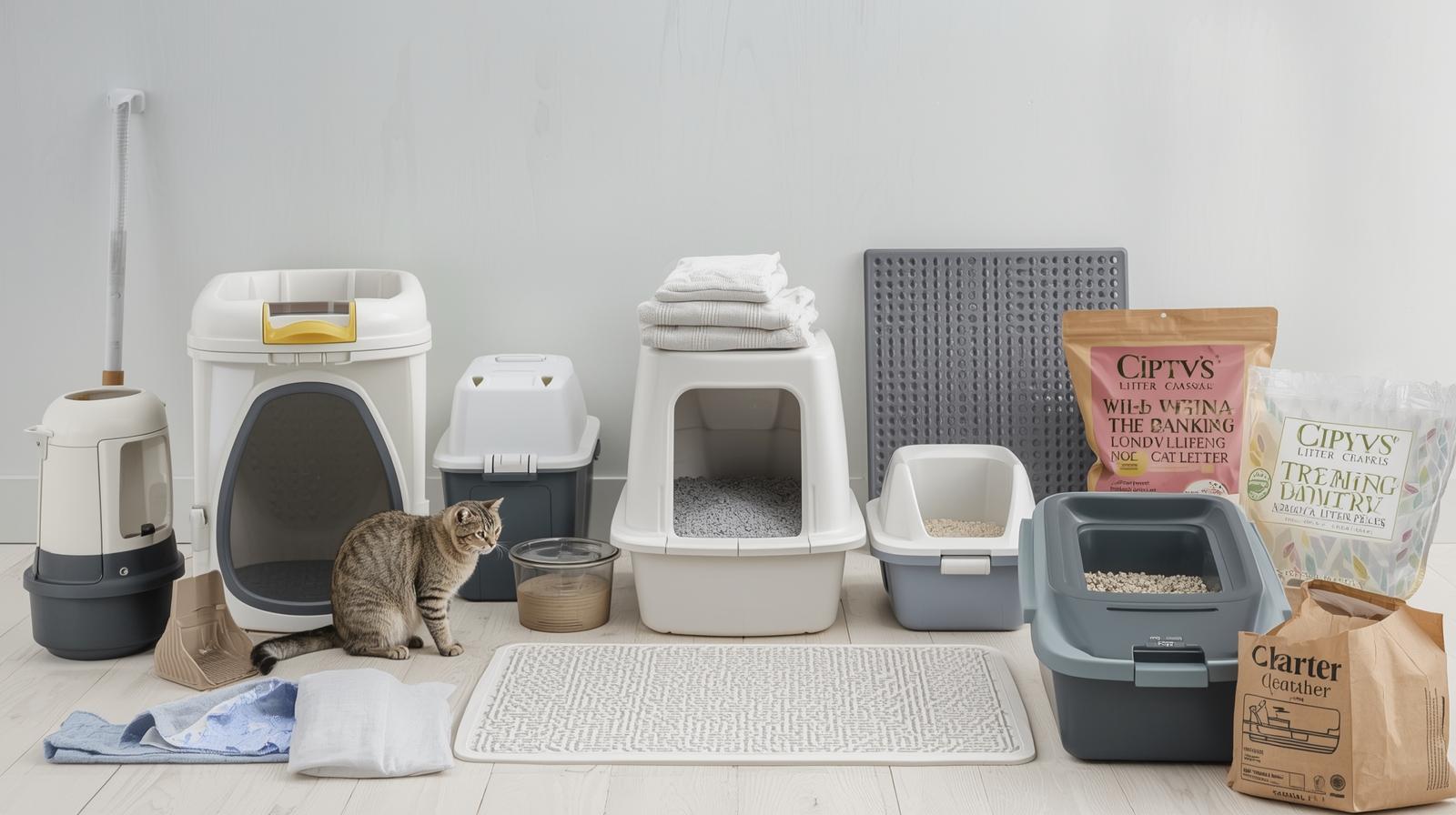Introduction:
1.Why Litter Box Training Matters
If you’ve ever owned a cat, you know that a clean home starts with successful Litter Box Training. Proper training keeps your space odor-free, prevents accidents, and ensures your feline feels secure and comfortable.
Cats are naturally clean animals — but without guidance, even the smartest kitten can make a mess. This guide will help you understand how to train your cat to use the litter box easily and effectively, using methods trusted by veterinarians and pet experts worldwide.
🧠 Fact: Over 90% of cats can be fully litter-trained within 2 weeks with consistent technique and environment.
2. Understanding Cat Behavior
Before starting Litter Box Training, it’s vital to understand why cats use litter boxes naturally.
-
Instinctual Digging: Cats have an innate desire to bury waste — it’s a survival behavior to hide scent from predators.
-
Territory: A consistent litter area helps your cat mark a safe zone.
-
Cleanliness: Cats prefer clean, odor-free spaces and will avoid dirty boxes.
Knowing this helps you align the training process with your cat’s instincts rather than forcing behavior.
🐾 External Reference: Understanding Feline Behavior — ASPCA
3. Choosing the Right Litter Box
The type of litter box you choose makes or breaks the training process. Cats reject uncomfortable, cramped, or smelly boxes.
Key Factors to Consider:
| Factor | Description |
|---|---|
| Size | Large enough for your cat to turn comfortably. |
| Height | Low entry for kittens or older cats; higher sides for adults. |
| Covered vs. Open | Covered boxes offer privacy; open ones provide better ventilation. |
| Material | Plastic is standard; easy to clean and durable. |
| Number of Boxes | Rule: 1 box per cat + 1 extra. |

Top Litter Box Types:
-
Open Pan Boxes: Simple and easy to access.
-
Hooded Boxes: Great for privacy and odor control.
-
Self-Cleaning Boxes: Ideal for busy owners (e.g., PetSafe ScoopFree).
-
Top-Entry Boxes: Prevent litter scatter.
🐈 Pro Tip: Start training with a basic open box before introducing automatic ones.
4. Best Cat Litter Types for Training Success
Different cats prefer different textures, but some litters make Litter Box Training easier than others.
Common Litter Types:
| Type | Features | Best For |
|---|---|---|
| Clumping Clay | Easy cleanup, odor control | Beginners |
| Silica Gel Crystals | Absorbs odor, low dust | Sensitive cats |
| Recycled Paper | Eco-friendly, soft | Kittens |
| Natural Corn/Wheat Litter | Biodegradable, safe if ingested | Eco-conscious homes |
| Pine Pellets | Natural scent, minimal tracking | Large cats |
Read More: Best Cat Litter Types — The Humane Society
5. Step-by-Step Litter Box Training Guide
This is the heart of Litter Box Training — follow these 8 proven steps:
Step 1: Choose the Right Spot
Pick a quiet, low-traffic area. Avoid noisy laundry rooms or kitchens. Cats value privacy.
Step 2: Introduce the Box Early
If it’s a kitten, place them in the box right after meals or naps.
Step 3: Show How It Works
Use your fingers to gently dig in the litter — cats imitate naturally.
Step 4: Reinforce Positive Behavior
When your cat uses the box, praise them softly or give a small treat.
Step 5: Keep It Clean
Scoop daily. Cats will stop using a dirty box.
Step 6: Avoid Punishment
Never yell or push their nose into accidents — it causes fear and avoidance.
Step 7: Handle Mistakes Calmly
Clean accidents with enzyme-based cleaners (like Nature’s Miracle).
Step 8: Gradual Independence
Once consistent, slowly move the box to your preferred location.
6. Common Litter Box Problems & Solutions
Even trained cats sometimes regress. Here’s how to troubleshoot common issues:
| Problem | Cause | Solution |
|---|---|---|
| Avoiding the box | Dirty or smelly box | Clean daily; replace litter weekly |
| Urinating outside | Box too small or wrong type | Upgrade to larger open pan |
| Scratching around box | Dislikes litter texture | Try softer, unscented litter |
| Frequent accidents | Medical issues | Consult a vet |
| Digging too much | Boredom or anxiety | Add toys nearby to redirect energy |

7. How to Train a Kitten vs. Adult Cat
Kittens
-
Begin Litter Box Training as early as 4 weeks old.
-
Use low-sided boxes for easy access.
-
Keep litter soft (paper or corn).
-
Be patient — kittens learn by repetition.
Adult Cats
-
Gradual transition is key, especially for rescues.
-
Show the box location several times a day.
-
Maintain strict cleanliness.
-
Reward consistently.
🧠 Note: Cats rescued from outdoor life may take 1–2 weeks longer to adapt.
8. Cleaning & Maintenance Tips
Cleanliness is crucial for effective Litter Box Training.
Daily Routine
-
Scoop waste 1–2 times per day.
-
Stir litter to prevent clumps sticking to bottom.
Weekly Routine
-
Replace all litter.
-
Wash the box with warm water + mild detergent.
-
Dry thoroughly before refilling.
Avoid:
-
Ammonia-based cleaners — cats hate the smell.
-
Strong fragrances — they mask scent but repel cats.
9. Best Litter Box Products to Try
Here are some top-rated Litter Box Training essentials:
| Product | Type | Why It’s Great |
|---|---|---|
| PetSafe ScoopFree Self-Cleaning Box | Automatic | Minimal effort; odor control |
| Frisco High-Sided Litter Box | Manual | Prevents litter scatter |
| Nature’s Miracle Cleaner | Enzyme-based | Removes urine odor |
| Arm & Hammer Clump & Seal Litter | Clumping clay | Superior odor protection |
| Iris Open Air Litter Box | Open pan | Great for beginners |
10. FAQs About Litter Box Training
Q1. How long does litter box training take?
A: Usually 1–2 weeks with consistent routine.
Q2. Can I train multiple cats together?
A: Yes — but each cat should have its own box.
Q3. My cat suddenly stopped using the box — why?
A: Stress, cleanliness, or medical issues are common causes.
Q4. What’s the best litter for kittens?
A: Non-clumping, soft-textured litter (like paper pellets).
Q5. Should I move the box often?
A: No — cats need consistency. Move it gradually if needed.
Conclusion: Building Lifelong Habits
Mastering Litter Box Training is one of the most important steps in raising a happy, clean, and confident cat. With the right setup, patience, and consistency, your feline will learn quickly and naturally.
Remember — cats crave cleanliness and comfort. Keep their litter area spotless, reward good behavior, and avoid punishment. In return, you’ll enjoy a stress-free home and a well-trained companion.


